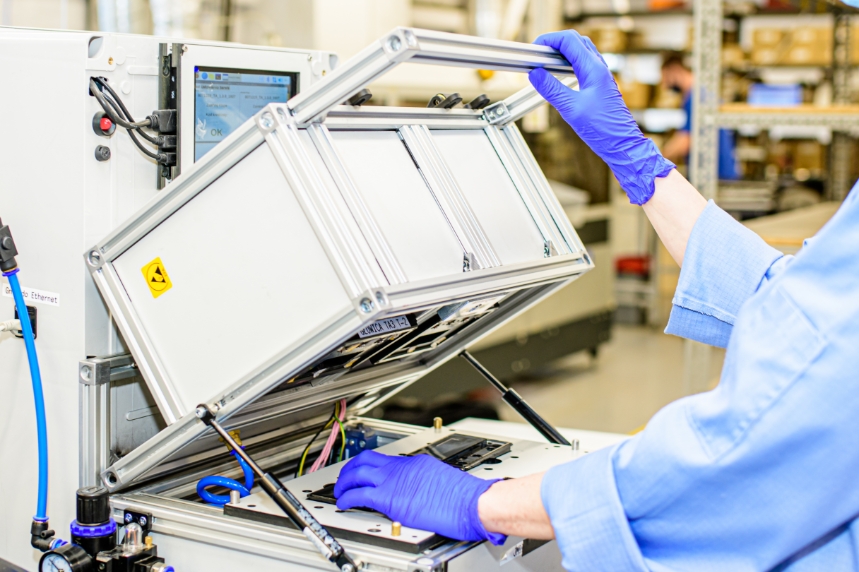
Abbreviations and names commonly used in the electronics manufacturing industry
AVL (Approved Vendor List): list of approved suppliers. Accompanies the bill of materials (BOM).
BOM (Bill of materials): full list of a raw materials, sub-assemblies, parts and quantities of each needed to manufacture an end product.
Box-build: also known as systems integration. Can be anything from a simple PCB housed in a small enclosure to cabinet housing a complex electromechanical system. An electromechanical assembly process that includes the assembly of the enclosure, subassemblies, components and cabling or wiring.
Cleanroom: specially constructed enclosed spaces with highly controlled environmental parameters such as temperature, humidity or living organisms. This allows to maintain control over the cleanliness of the environment. Used for assembly / packaging of sensitive components or products (displays, cameras, other optical elements, transparent housing elements).
CEM (Contract electronics manufacturer): companies that take responsibility under the contract for design, assembly electronic products, engineering services, order fulfillment, product distribution and after-sales services. See also EMS.
CAR (Corrective action request): an action item in which the requesting party (OEM or CEM manufacturer) asks the responsible party to conduct a root cause analysis and assist in solving the problem.
DFM (Design for manufacturing): the process that integrates the principles of production with the design and development stages of the product to be manufactured.
DFT (Design for test): Process that is usually combined with DFM to optimize product design for testing in the production stage.
EMS (Electronics manufacturing services): industry providing custom design, manufacturing and manufacturing service on behalf of OEM. Traditional services include PCB assembly, box-build and testing. Currently EMS companies provide additional services such as supply chain management, distribution, logistics, warranty repairs. However, the intellectual property associated with product belongs to OEM. EMS providers are also called contract manufacturers (CEMs).
ECO (Engineering change order): change request to the production process (to the BOM, assembly instructions, AVL). Typically these are: replacement one component with another, removal specific elements. Such changes are often very complex and have a very significant impact on costs and quality at the same time. Each ECO should be documented and handled accordingly to specific procedure.
Excess stock: warehouse of unnecessary materials left after production or left after introduced changes. Usually such excess is put on sale by electronic components brokers.
First-pass yield: the percentage of the quantity of the tested product that passed the quality control the first time.
IP – Intellectual property: any product of the human intellect that is unique, innovative and non-obvious and has a certain value on the market. These are e.g. ideas, inventions, business methods and production processes.
LT (lead time): period of obtaining, delivery time from suppliers.
MES (manufacturing execution system): computerized systems used in manufacturing to track and document the transformation of raw materials to finished goods.
MOQ (Minimum order quantity): minimum number of units required to be purchased at one time.
MSL (Moisture Sensitivity Level): standardized level of sensitivity to moisture – determined for many electronic components where moisture is a risk of damage during soldering processes. Some of these elements require appropriate storage conditions in sealed packages.
NPI (New product introduction): the process of introducing a new product – from the design to the production with achieving the expected costs, quality and time-to-market.
NRE (Non-recurring expenses): one-off expenses for tools, instruments and activities required by the EMS provider for a specific OEM product. Usually these are machine programming, quality control instruments. These one-off charges are priced separately from product costs.
ODM (Original design manufacturer): a company that designs and then manufactures products that are sold under the OEM brand name. Project is based on OEM requirements but usually ODM determines the product specification adapting it to the expectations of a specific OEM customer. Unlike EMS provider, ODM designs products based on ODM intellectual property. This model allows the OEM to offer the product to the market faster.
OEM (Original equipment manufacturer): company that usually designs and then introduces products to the market under its own brand. OEMs design products, purchase components from suppliers run their own production facilities and are involved in sales, service and support. Nevertheless, many of these functions are now outsourced.
Outsourcing: subcontracting of specific processes. In the EMS industry its often product design or manufacturing.
PCBA (Printed circuit board assembly): the assembled circuit board of an electronic device that has passed through the surface mount process (SMT) and subsequent phases of the production circuit board.
RFQ (Request for quotation): The document of the request for quotation from the OEM to the EMS provider. This usually includes the BOM, product and quantity specifications and often the AVL. Other requirements for the EMS that will later form part of the contract are also presented at this stage.
RMA (Return materials authorization): permission to return the goods – in the product complaint process – it allows to assign identification numbers of the packaging of the returned products and to determine the repair / replacement process during the product warranty period before sending back.
RoHS (Restriction of Certain Hazardous Substances): The EU Directive intended to limit the use of hazardous substances in electrical and electronic equipment. Directive is applicable since 1st July 2006. Restriction of the use of certain hazardous substances such as lead, cadmium, mercury, hexavalent chromium and brominated flame retardants (PFR) PBB and PBDE. There is now a third revision of this directive.
SMT (Surface-mount technology): method in which the electrical components are mounted directly onto the surface of a printed circuit board (PCB). Further stages of mounting usually are carried out by THT method.
THT (through-hole technology): the traditional way of assembling elements on a PCB. Currently used for larger components or older generation products.
Time to market: the time needed to introduce the product to the market. A short TTM is crucial for market competitiveness. The goal is to get to the market with the new product faster than anyone else. Being the first in the market can increase a company’s profit margin and market share.
Vendor-managed inventory: the process by which the supplier owns the components until they are released or given to the production line. Typically VMI is served by a distributor who has set up a consignment warehouse in the manufacturing facility.
WEEE (The Waste Electrical & Electronic Equipment): EU Directive that aims to minimise the impact of such equipment on the environment during the products’ life span and when it becomes waste. Encourage the design of electronic products with environmentally-safe recycling.
WIP – Work in progress: the stage in which the raw material goes to the production hall and the production process takes place. After its completion the finished product will be created.



